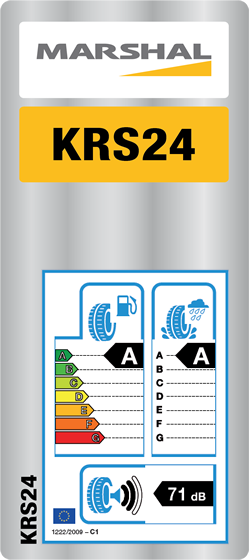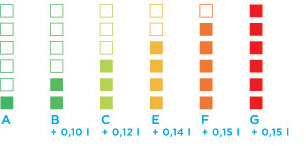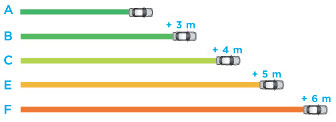The new tyre label: for increased
transparency and safety
On 1 November 2012, the new EU regulation 1222/2009 on the labelling requirements for motor vehicle tyres comes into effect. The tyre label applies to all new tyres produced after 1 July 2012. The new label will make it easier to identify and compare three important performance characteristics: braking performance in wet conditions, noise levels and fuel efficiency.

Fuel efficiency
Rolling resistance and associated fuel efficiency.
A is the best score (Class D not included).
More details
Rolling noise
All tyres must comply with the noise limit; the fewer the black stripes, the less noise the tyre makes.
Reference to Regulation 1222/2009-C1, C2 or C3.

Fuel savings depend fundamentally on the vehicle and driving conditions. If a vehicle is fitted all round with Class A tyres as opposed to Class G, fuel consumption can potentially be reduced by up to 7.5 %. This value can be even higher with commercial vehicles.

The degree of effectiveness depends fundamentally on the vehicle and driving conditions. With full brake application, the braking distance can be shortened by up to 30 % on a vehicle fitted all round with Class A as opposed to Class G tyres. On a “normal” car travelling at a speed of 80 km/h, the braking distance on a road surface with average grip can be up to 18 m shorter.
External rolling noise
The external rolling noise of the tyre is measured in decibels. It should be noted here that the external rolling noise of the tyre does not correlate with the noise in the vehicle interior.
The pictogram with three black stripes means that the external rolling noise of the tyre complies with the EU upper l
Two black stripes indicate that the external rolling noise of the tyre complies with the EU upper limits that will apply from 2016 or are up to 3 dB below the limit.
One black stripe indicates that the external rolling noise of the tyre is more than 3 dB below the EU upper limits that will apply from 2016.
Tyres play only a part in delivering the overall fuel economy of your vehicle. As a driver you can influence the fuel consumption of your vehicle by driving in a mild smooth manner. Avoid hard acceleration and try to anticipate traffic movements ahead to avoid unnecessary braking and hard deceleration. Keep a safe distance from the vehicle in front at all times to avoid collision in the event that you may have to brake hard.
Fuel consumption will increase with underinflated tyres and excessive over-inflation has the potential to lower grip level. Set your tyre pressures according to the vehicle manual and check them regularly to get the best balanced performance.

